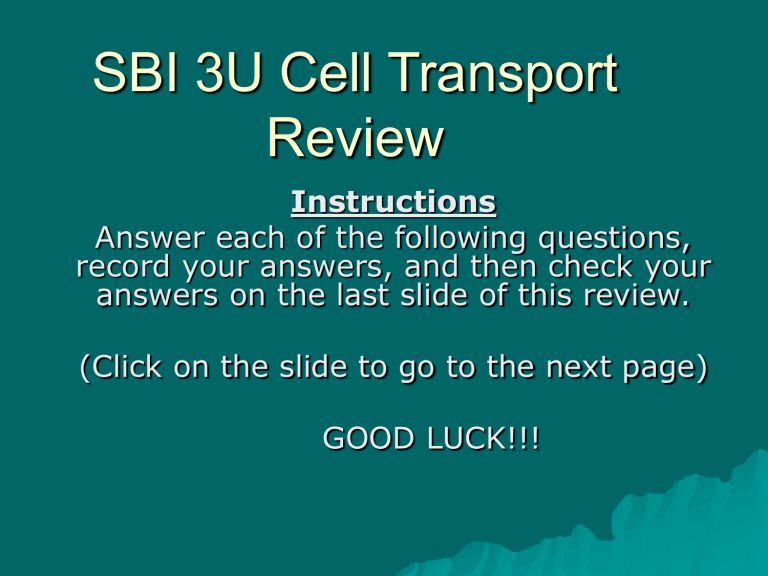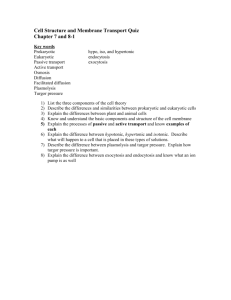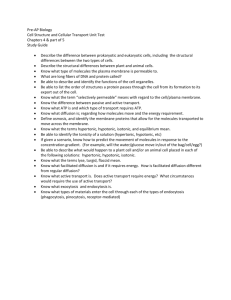SBI 3U Cell Transport Review

SBI 3U Cell Transport
Review
Instructions
Answer each of the following questions, record your answers, and then check your answers on the last slide of this review.
(Click on the slide to go to the next page)
GOOD LUCK!!!
1) Name of the process by which vesicles containing cell products move towards the cell membrane and expel their contents into the extra-cellular fluid.
2) The shrinking away of the cell membrane from the cell wall.
3) The bursting of an animal cell due to osmosis.
4) The spontaneous movement of particles from an area of high concentration to an area of low concentration
5)The fluid bathing the outside of a cell.
6) Type of solution where cytolysis occurs
7) Microscope that uses beams of electrons instead of light to produce
Images.
8) The cell membrane’s bilayer is composed mainly of this type of molecules.
9)Since the phospholipid bilayer has a fluid consistency and is studded with protein molecules, this is the name of the model representing it.
10) The steady state that results from maintaining near-constant conditions in the internal environment of a living thing
11) A cell that is permeable to some substances, like water, but not to others
12) What is the difference in concentration between two regions called?
13) The diffusion of water across a selectively permeable membrane.
14) The process of moving substances against their concentration gradient
15) Membrane protein with a tunnel like shape that allows charged particles
(ions) to pass through
16) The most specific type of endocytosis.
17) The ability to clearly separate details.
18) Cell “drinking”.
19) Cell “eating”.
20) Small spherical structure formed by pinocytosis, containing E.C.F
21) Type of solution where crenation may occur.
22) Type of solution where plasmolysis may occur.
23) Type of solution where plants are more likely to wilt.
24) Type of solution where turgor pressure decreases.
25) Type of solution where turgor pressure increases.
26) Type of solution where dynamic equilibrium exists
27) True or False: a)Diffusion is an example of active transport b) Osmosis is an example of active transport c) Facillitated diffusion is an example of active transport d) Exocytosis is an example of bulk transport
True or False:
28) Active transport involves moving a substance against its concentration gradient
True or False:
29) The tail region of phospholipids is hydrophilic
True or False:
30) The sodium-potassium pump is an example of active transport
Answers:
1) Exocytosis 2) Plasmolysis 3) Cytolysis or Lysis 4) Diffusion
5) Extracellular Fluid or ECF 6) Hypotonic 7) electron
8) Phospholipids 9) fluid-mosaic membrane model 10) homeostasis
11) selectively permeable membrane 12) concentration gradient
13) Osmosis 14) Active Transport 15) channel protein 16) Receptor-mediated endocytosis 17) Resolving Power 18) Pinocytosis 19) Phagocytosis
20) Vesicle 21) Hypertonic 22) Hypertonic 23) Hypertonic 24) Hypertonic
25) Hypotonic 26) Isotonic 27) a) F b) F c) F d) T 28) T 29) F 30) T






